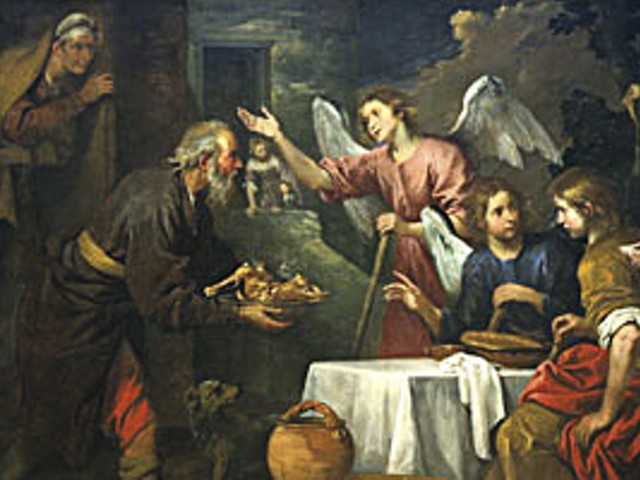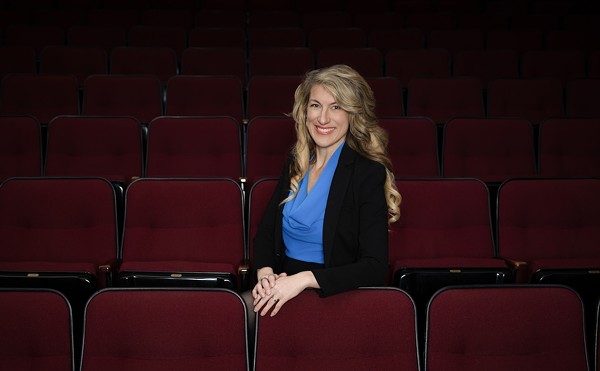Newly Reviewed
Fresh Paint St. Louis artist Kevin McCoy organized five "street-inspired" cohorts — Brooklyn, James Gates, Shadzilla, Vito and McCoy himself — to wrestle with the influence of the untamable medium of graffiti and produce new, gallery-fit art with the hope of broadening the group's appeal and the context and scope of how their work is appreciated. The small paintings, screen prints and digital prints the artists produced echo the heaped iconography and boldly scrawled messages of their urban counterpart, but in a tidy wall-hung context the work lacks the medium's key sense of unruliness. That aspect was captured at the show's opening: densely packed, DJed, with a hot-dog vendor and occasional bursts of break dancing and flash photography, the event made for a kind of performance that was aptly celebratory, broad-reaching and timed not to last. Through January 31 at Fort Gondo Compound for the Arts, 3151 Cherokee Street; 314-772-3628 or www.fortgondo.com. Hours: by appointment.
Holga Polka Invitational A county fair-esque display of 40-plus contributors' wranglings with the quirk-prone Holga camera. A plastic model mass-manufactured in Hong Kong in the '80s, the Holga best lends itself to capturing modest, peripheral incidents and typically un-photo-worthy details that, in the camera's flawed soft-focus, suddenly elude fixed time. The show cultivates a spirit of unwittingly attentive viewing that invites all to recompose their daily lives as something a little more than rigidly daily. In one square image, a city phone booth appears solitary and miraculous in a bare winter forest-scape; in a small triptych, a single cactus plant leans off-kilter against blue sky, teeters blurrily in a second frame and then, in the third, is replaced by the silver angularity of an airplane wing as viewed in flight through a passenger's portal window. Through February 22 at the Regional Arts Commission, 6128 Delmar Boulevard; 314-863-5811 or www.art-stl.com. Hours: 10 a.m.-5 p.m. Mon.-Fri., noon-5 p.m. Sat.-Sun.
Houska: Hi-Def Springfield, Illinois, transplant Charles Houska — an agendaless Keith Haring whose popular brand of flamboyantly sunny "art for everyday life" has decorated everything from credit cards and vodka ads to children's-hospital doors and animal-shelter walls — abandoned the product line for the studio to create this show of new acrylic-on-canvas paintings. The yield, though, is more of the same: reliably branded imagery of a wide-eyed world of rainbowed landscapes and ubiquitous smiles, rife with blind optimism and heedless populism, that's better fit for brightening the public realm than the private auspices of a commercial gallery. Then again, opening-night sales did benefit Food Outreach, and any gallerygoer who loves brazen depictions of unflagging happiness will be undoubtedly gratified, as the work remains as innocent-seeming as a coloring book. Through February 21 at phd gallery, 2300 Cherokee Street; 314-664-6644 or www.phdstl.com. Hours: noon-4 p.m. Thu.-Sun.
Ideal (Dis-) Placements: Old Masters at the Pulitzer Reviewed in this issue.
Ongoing
InterActive: New Technologies in Contemporary Architecture Washington University instructor Jasmin Aber, former coordinator of the Shrinking Cities Center at UC Berkeley's Institute of Urban Design and Regional Development, guest-curates this brief survey of new approaches to integrating technology into the built environment. Via photographs, schematic renderings and video simulations, the exhibit presents examples of contemporary urban structures that have been outfitted with reactive digital programs to produce large-scale light displays and other 2-D projections of computer-generated information stimulated by public interaction and/or shifting environmental conditions. The zeitgeist — evidently flourishing in global metropolises Berlin, Beijing and London — is a multivalent one, addressing issues of energy conservation, population management, and the current and future scale of urban density. In sum, the show offers a small but importantly informative window on wider-flung and alternative modes of modern living, which unavoidably involves negotiating the heroic and destructive potentials of invention. Also showing: Michael Eastman's interior photographs of the Charleston, South Carolina, historic landmark the Aiken-Rhett House — in their near-tactile depiction of weathered and abandoned domestic opulence — provide a striking complement (or antidote) to Aber's assembled virtual-realities of the moment. Through January 24 and February 14, respectively, at the Sheldon Art Galleries, 3648 Washington Boulevard; 314-533-9900 or www.thesheldon.org. Hours: noon-8 p.m. Tue., noon-5 p.m. Wed.-Fri., 10 a.m.-2 p.m. Sat.
Reviews of local visual art exhibitions, by Jessica Baran. (Show previews are labeled as such.)





